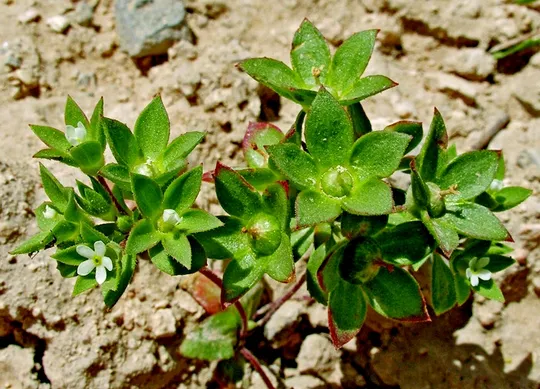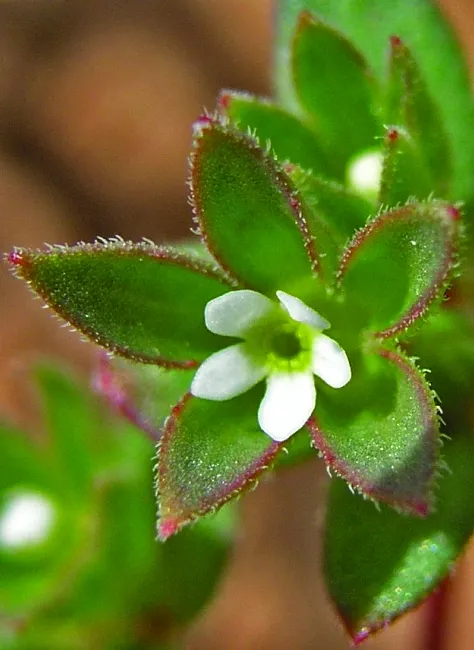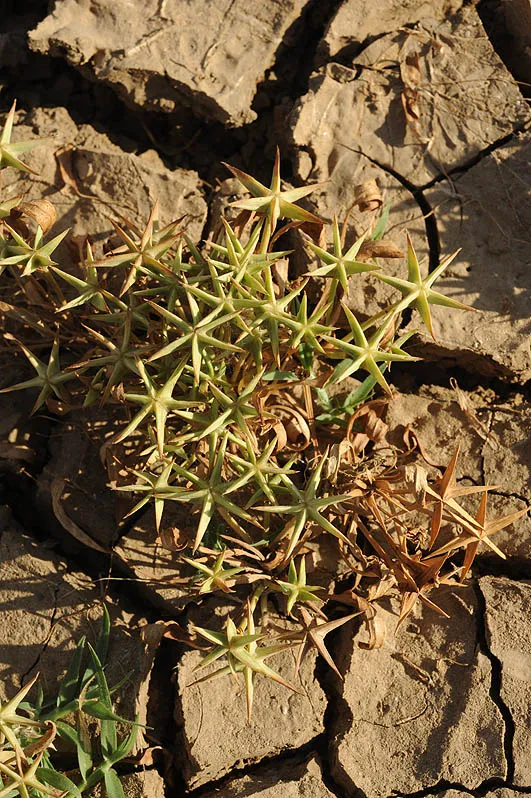Greater Rockjasmine, Greater Androsace
Androsace maxima


Androsace maxima is a tiny, erect annual herbaceous plant, 3-6 cm tall. Its leaves are mostly arranged in a basal rosette. White, pentagonal flowers, 3-4 mm across are arranged in a pseudo-umbel at the head of the stems. The corolla has a short tube (1-2 mm); its mouth narrows gradually due to a fold that creates a brown-colored ring. The corolla is usually shorter than the calyx. The flower falls after one day of blooming. The ripe calyx swells and grows upon ripening. Fruit is a capsule with five valves that open almost to the base, and few seeds. A. maxima blooms in the second half of March at low altitudes and in April in higher areas. On Mount Hermon, it blooms in the transition zone montane forest in May.
Androsace maxima are found in three regions in Israel: the Negev Highlands, the Judean
Mountains and the Judean Desert. It is very common in the mountainous forest on
the Hermon. In the Negev Highlands, it was found only once in upper Wadi Nitsana.
In Samaria it grows at Ba'al Hazor and on Mt. Grizim. In the Jerusalem-Judean
Desert Bet Lehem region, there were a significant number of collections in the
20th century. In the Jerusalem area, it was collected in the past in
Talpiot, Mount Scopus and the Valley of Hinnom, but over
the past 20 years, the species has become very rare. It was found just once in
1998 on Mount of Olives and in 1970 in a field at El-Azaria. In 2003, Oz Golan
discovered fine populations of A. maxima on the Ma'on Ridge in the southern Judean Mountains; these populations
are stable from year to year.
The species
grows in open areas on rocky, sunlit slopes, on the peaks of arid mountains and
in the Mediterranean-desert ecotone at altitudes above 800 m. It also accompanies
traditionally cultivated fields in the ecotone.
The genus Androsace
includes about 100 species that grow in the
temperate regions of the Northern Hemisphere. Most of the plants are alpine
perennials that grow on rocks and create dwarf cushions to protect themselves
from wind and blizzards. Its speciation center is in the Himalayan Mountains,
where Androsace species are known as plants with abundant, colorful flowers, much
larger than the dwarf cushion plants. The species found in Israel is a diminutive
annual version, adapted to the Mediterranean climate and to self-pollination. Thus,
the flower is small, colored pale cream-white and attracts only a few
pollinators. Androsace belongs to a small annual plant group adapted for rapid growth following
the melting of snow and to form fruits before the beginning of the primary
alpine spring.
The plant’s distribution in Israel shows, on one
hand, an affinity to high mountains, such as the Hermon, Negev Highlands and
the Ma'on Ridge; on the other hand, it was collected in the
Mediterranean-desert ecotone in the Jerusalem area, and a few times even in the
Judean Desert proper. The plant is very common in Jordan, on the Moab and Edom
plateaus. This distribution pattern suggests an ecotone plant that was displaced
to a lower ecotone, and even into the desert. It is possible that the locations
found in the Judean Desert are sinks to the mountain range in the Jerusalem
area, which could explain the small, episodic observations of Androsace in the region.
The area is densely surveyed and in 2003, a special survey of rare plants was
conducted there (Shmida and Ron).
·
Accelerated construction and
development have led to the extinction of most of the Androsace
maxima locations in the Jerusalem-Bet Lehem-Wadi Qelt area.
Its habitat in this region is exposed, sunlit slopes on mountains above an
altitude of 750 m, of which 90% was destroyed due to construction and roads.
·
Although Androsace
maxima is threatened in Israel,it is not globally
threatened.
·
Protected in the Negev
Highlands Nature Reserve.
The few remaining sites on the central mountain
range where Androsace
maxima, as well as other red plants grow should be
prioritized for preservation.
Androsace maxima have a broad distribution, which includes the Mediterranean region,
the Irano-Turanian region and penetrates the Euro-Siberian region as well. In the
Mediterranean Sea Basin, it grows in all of the countries surrounding the sea.
It is common on the Hermon mountainous belt. In the Middle East, it grows in
Iraq, Iran and Afghanistan and penetrates the Pontic region in the Caucasus and
southern Russia.
Androsace
maxima are a diminutive annual plant growing on high
mountains and plateaus in the Mediterranean-desert ecotone. It grows in a few
locations on the Negev Highlands, Ma'on Ridge and at Mount Scopus. It is
threatened by the reduction of its locations and its populations.
Current Occupancy Map
| 1000 squre meter pixel | 5000 squre meter pixel | 10000 squre meter pixel | |
|---|---|---|---|
| number of observations | 0 | 0 | 0 |
| in total pixels | 0 | 0 | 0 |
| Family | Primulaceae |
| Classification | On the endangered species list |
| Ecosystem | High Semi-Steppe |
| Chorotype | Western Irano-Turanian (Mediterranean, Euro - - Siberian |
| Conservation Site | Mitspe Ya'ir on the Ma'on Ridge |
| Rarity |
1
3
6
|
|---|---|
| Vulnerability |
0
3
4
|
| Attractiveness |
0
0
4
|
| Endemism |
0
0
4
|
| Red number |
1
3.2
10
|
| Peripherality | 0 |
| IUCN category | DD EW EX LC CR EN VU NT |
| Threat Definition according to the red book | Vulnerable |
 Based on:
Based on:






